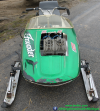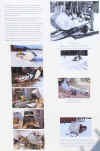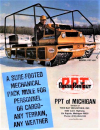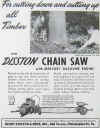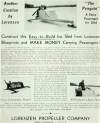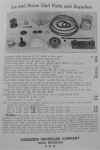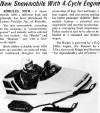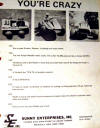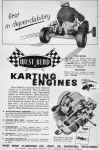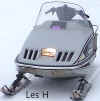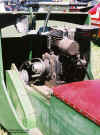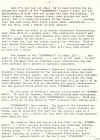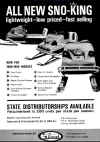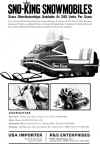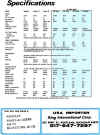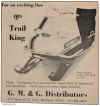Snowmobiles & OSVs
Air-Sled-It
Over Snow Vehicle (OSV) Air-Sled-It. It started out as a two-seat
trainer before it was wrecked in 1930. Two Michigan residents, John
Caldwell and Robert Elwell of St. Clair, removed the wings and
mounted runners below the fuselage. Testing on Lake St. Clair on
January 11, 1931 they hit 85 MPH near their operating location at
the end of 12 Mile Road.



Anderson
Manistique area residents Clay Anderson and his son
Melvin built five snowmobiles in the late 1950s and early '60s.
First in 1957 after seeing a sled in Popular Science magazine. Of
note, Mr. Anderson designed and built the transmission with a
High/Low range, reverse, and neutral. The machines were made to haul
logs. A 1963 Anderson is displayed at the Top of the Lake Museum in
Naubinway.


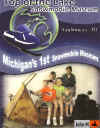
Arnet
Woodland resident O.A. Arnet looked at the early Automotive type
sleds and thought they were too complicated. His Automobile Sled
greatly simplified drive systems; novel ideas of an efficient brake
mechanism where vehicle speed was regulated and the rear runners
could be lifted when driving over patches free of snow and ice.
Considering he filed for a
patent in 1910 is impressive, very impressive.
.
Automotive Snow-Track
Leonard LePage was a dual citizen (CDN/USA) who made his home in
Roseville, Michigan. He was a very clever person and expert
tool and die maker. In the 1940s, while serving in the
Canadian Armed Forces in northern Canada he noticed (of course) you
need an automobile to get around a good part of the time; however,
in deep snow there were two obstacles: 1. There wasn't
many motorized Over (the) Snow Vehicles (OSVs) at that time.
2. What OSVs there were--were very expensive for the average
person to afford. He thought, why does there need to be different
vehicles for different uses? It's less expense to use a base
vehicle and modify it for the task at hand. When his service
time was up he came back to Roseville to work on his plan for a
multi-use family vehicle. He developed an endless track system
that went around the whole automobile, not under it like a tank or
bulldozer. This system was slick because it took only an hour
to install it. The dual tracks were not cleated, his rubber
track(s) was light like snowshoes. Standard tires transmitted
power to the tracks. To steer he added a simple differential
braking system. Once the system was installed it only took a
couple of minutes to remove and reinstall the tracks. In the
early 1950s, he tested it in Northern Michigan hitting a speed of 50 MPH
with plenty of power left
and the system worked great in deep snow. His next step was
making a Boatmobile. In the mid-1950s people had to take
a double take watching Leonard take his family cruising up and down
the shores of Lake St. Clair in his family's car he made into an
amphibious vehicle. Even though he made his dream come true for
people to have a truly one multi-use vehicle the Post WW II Baby Boom
era people just didn't have time for it paying mortgages and raising
families. I wish to thank the Crowley and Lepage families for
help in my research for this.
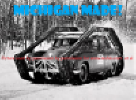
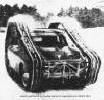
Barrel Sled
Little is known, not even the correct name. Seven were made
in Northern Michigan Leelanau County from 1962-1963. Of the two
known, one is Blue the other White. Powered by a Four-Cycle
Wisconsin Engine. Click
here for a video of it in action. Pictures used by
permission, thank you to The Winning Edge Magazine and Cliff S.
Also, thanks to Cliff S and Steve H for info so far.

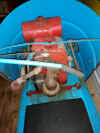
Big Boss
Big Boss Snowmobiles were made by Aurora Engineering just
east of Ovid from 1970-1971. A couple were Northways; however, the
rest were made in Michigan. Of note, Fratelli Guidetti Engines from
Italy were in the works but, mostly CCW and Sachs engines were used
with a couple of Tohatsu motors. Only two Big Boss racing
snowmobiles were made. The first was Ovid's Gary Luce's Big Boss
with a 553cc Tohatsu engine for the 1970 Soo I-500 (Of note, he did
not make the starting field just missing that last spot that was
59.3 MPH). The second was powered by a 740cc Sachs Twin Free
Air engine that raced out of Wells, Michigan during 1971 season in
Central and Western Upper Peninsula; Northern Wisconsin. A Big Boss
option was the impressive four-wheel kit by Land-Grabber in Window,
MN. Interesting to note, the Land-Grabber was the winner, Special
Events Award category, at the 1970 Inventor's Congress.
Picture shows a Land-Grabber mounted on a Big Boss. Very few are
known to exist.



Brannon
James Blaine Brannon, AKA Blaine Brannon, was on the cutting edge
for many things for the Michigan Conservation Department. In 1930,
he spearheaded some of the first Michigan Deer Food Plots while
refuge keeper of the Ogemaw Game Refuge. A year later he invented
the Dancing Pigeon Owl and Hawk trap. In 1936 while in the Upper
Peninsula he won the Original Jack Pine Lodge Tavern in a poker
game. In 1937, he was transferred to the nearby Cusino Refuge so he
could be close to the lodge. At Cusino he invented the Deer-Browse
experiment. With much more snow and a vast area winter inspections
where hard and slow using conventional means even with track
conversions. While CB Wing in St. Ignace had been building Aero
Sleighs since the 1910s Brannon had a better Snow Plane in mind. He
designed and built one where the motor is closer to the ground, for
stability, with power to the propeller by V-Belts. He also put in a
retractable fin down the center of the front skis (pushed up when
obstacles are encountered) for increased steering. On a side note,
just three years after he build cabins at the Jack Pine Lodge,
Blaine died in 1948 at his Jack Pine Lodge residence during a fire.
When a former state trooper, a waitress, and Mrs. Brannon at the
Tavern first noticed the fire, it was too late, the blaze was only
125 feet away.

![]()
Buhr-Russell
In 1914, Michael Buhr and Edward Russell of Hamtramck tested their
Motor Sleigh on Sylvan Lake near Pontiac. Powered by a 52hp
Pope-Toledo engine coupled to a six-foot diameter propeller they hit
128 mph without wide open throttle. Their goal was 140+ mph and to
break all ice speed records on Orchard Lake soon. In all the
prototype (in 1913) and three ZIP models were made with Edward doing
most of the driving. They were planning
on a consumer, slower, version that could be used on thoroughfares
and rural areas in Northern Michigan. After 1917 we have found
nothing more on their efforts or what happened to each of them.
Can you help?


Chisholm
J.S. Chisholm's, from Detroit, idea was a power Motor Sleigh using
helically disposed transmission runners where in theory the greatest
possible load carrying and propelling efficiency could be obtained.
He was right, on ice, light snow conditions, and low-medium hard
pack. But, on medium-heavy unpacked snow ground surface pressure was
too high and the end result was sinking up to the frame. Also,
follow-on safety protection devices added a great deal of weight.
Chisholm applied for a patent on May 5, 1916 (US1254749)
and was awarded Jan. 22, 1918.

Drake Invader
Drake Industries in Ferndale during the middle 1970s under a contact
with Northway to build race sleds. The first "Invader" was labeled
Northway; then Northway ceased operations. The 11-20 Invaders built
were strictly for racing using at first Texas Products Single Track
Manta chassis with Sachs 340cc and 440cc Free Air engines in '74/'75
and Kohler Liquid Cooled engines in 1976. Of note, Kohler heat
exchangers were mounted in the skis. One Invader had IFS and with a
1977 Yamaha SRX engine. Drake Industries had a factory race team
with two drivers on the MISA circuit and a couple SnoPro races; a
few of Invaders were seen on the Michigan Summer MISA Grass Drag
circuit. The factory team at one time or another used the three
power plants along with a German Konig 246cc Type FA marine racing
engine that created 58 hp at 11,500 PRM using Alcohol/Castor Oil
Mix. On the picture don't look too hard at what type carburetors
those are, specially built by Konig. On the last picture it's Darrel
Krane racing an Invader at Imlay City, Michigan. Thank you to David
R and Shane S for help and photos.


Dupras
The Dupras name in the Marquette area is well known, not only
because it is a very common name in that part of the UP, but they
are hard working and intelligent folks. Frederick Dupras
greatly contributed to this legacy in the early 1900s when he
designed and built one of the first human powered snowmobiles. He
was granted a
patent in 1903. Frederick died too young, but his drive to
conquer the snow lived on through his relatives who made the
Dupras
Snowmobile (below) decades later in the 1950s.

Dupras
Two were thought made in the Marquette area in the 1950. Only one is
known to survive in private collection. From more information
on the Dupras' family's efforts to conquer snow travel please see
the Durpas bicycle above.


Dwyer
Manufactured by the Dwyer Machine Shop in Wolverine only two Dwyer
snowmobiles are thought to exist and were built around 1960. One is
powered by a Clinton; the other a Kohler (both Four-Stroke engines).
The Michigan Conservation Department used a Dwyer up to winter 1963

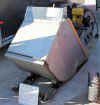

Easy Rider
The Easy Rider made in Elk Rapids, Michigan started out as the
PasseParTout (PPT) in Quebec in the early '70s. PPT is French and it
means Pass By Everything in English. It was touted as an ATV,
but many consider it strictly a snowmobile and the marketing
material by the Sales Department targeted it as such. In the late
'70s the company was sold to Valquentin and moved to Alberta. After
a couple years it was sold to Consolidated International, Inc.,
Columbus, Ohio, whose subsidiary Twin Bay Industries, Elk Rapids
built the PPT under it's namesake for a very short time and then
under the name Easy Rider Twin Tracked vehicle. They also intended
to sell it to the US Army, but production ceased in mid-80s. Over
300 Easy Rider snowmobiles were made; however, very few exist today.
Videos of the Easy Rider:
Easy Rider 1
| Easy
Rider 2


Eliason
Most snowmobilers know about Carl Eliason's contributions,
huge, to the history of snowmobiling. However, very few know
he's from Michigan. Carl was born in the
Upper Peninsula in Ironwood 1899. About 10 years later
the family moved to the Sayner, Wisconsin area. Yes, credit
goes to Wisconsin because that's were he honed his craft. But,
in all due respect, it must be acknowledged he was born a
Michigander and a Yooper. The best place to learn more about Carl Eliason
is on the Eliason
website and the Eliason Museum (details on
website).
Many thanks goes out to the Eliason family
for reaching out to us and helping get his birthplace verified and
correct.

Engelhardt
The phrase, "Necessity is the mother of invention." come to mind
when thinking about Henry Engelhardt's OSV. The 1920s family
farm was 13 miles from Iron River, Michigan. Most roads were
not plowed and drifts well over 10-feet high in places made getting
into town, well almost impossible. Henry and his son made
their first OSV around 1925. They fashioned the hood and
seating to a wooden frame. Made two long wooden skis; along
with hand making the propeller. Using a motorcycle engine
moving the long wooden skis pushed the vehicle with ease like
an Eskimo Kometic in the Arctic. Over time they built made
three Engelhardt models for offer. Their biggest refinement
was using airplane engines for the powerplants like the one in the
photo. We will never know, but one could surmise the crash of
1929 ended the Engelhardt because very few people could afford food
let alone a snowmobile.

Erickson
Ben Erickson, a Swede, was like many that journeyed from Scandinavia
in the late 1800s and early 1900s in search of a better life via the
logging boom. The Nordics were a hardy bunch so when arriving in New
England/New York or Sydney, Nova Scotia it made sense to recommend
them to Michigan and Ontario where jobs were a plenty and they
should adapt well to the snow and cold, that they did. However, Lake
Effect was new to them--so much snow!
The Erickson Automotive Sleigh was Ben's idea to make life better in
his new country and town of Mapleton. He thought changing wheels or
modifying wheels with tracks was a waste of time. His double rim
invention instantly change a wheeled vehicle to a snowmobile via
pressed friction shoes. He submitted his idea in 1912 and granted a
Patent in 1915.

Erickson
& Larson
Axel Erickson and Nicklars Larson of Skanee invented Sled-Runner
attachments to convert bicycles into ice or snow cycles. They were
awarded a
patent in 1904.

Everleigh
Made in the Pickford area in the late 1940s. The Yale engine came
from a wrecked motorcycle.. The Everleigh was often seen out
on Hessel Bay. The engine is a later model Yale Motorcycle
V-Twin because the Bosch Ignition is mounted center instead of lower
on the early Yale V-Twins. Of note, the horizontal spark plugs in
the heads and across from each other is a dead given away it's a
Yale. If you look hard you can see the builder put a spare
spark plug in the rear upper engine mount. The Everleigh is in
a private collection in Michigan.


Ford
Back in the late 1960s there were many Ford Dealerships also selling
snowmobiles, mostly ski-doo. It caught Ford's attention so much it
warrant merit to evaluate for possible manufacture or offer a
branded snowmobile under the Ford name. For evaluation, much like
many other manufactures had done before, Ford chose a snowmobile
already in production. They wanted a company that was huge and
solvent; built a quaility product(s). They chose Columbia made by MTD
in OHio. The evaluation snowmobile
was a precursor to the 1972 Columbia 440 SST. It came with a JLO 440
Fan Cooled engine with single carburetor. In February 1971 Ford cut
a purchase order for a Columbia and it was delivered in late March.
The sled is Ford Tractor Gray and Ford Blue with a Ford Decal on
both sides of the hood, had other touches not on a Columbia
snowmobile. The project just faded away. Why after a short
evaluation period Ford cease their efforts is not known (we are
awaiting back a response to Ford). For years you could see it around
Gaylord, Graying, and Houghton Lake areas being used as intended. Here is a
video giving a quick
overview of the "Ford Snowmobile." Of note, the Ford
Snowmobile pictured below is up for offer at
Aumann Auctions as of 29 Aug 24.



Ford Cat Track
(F-100 Tracked Vehicle)
The US Military was planning on a very large scale Cold War exercise
in Alaska with Canadian and other forces for winter 1961-1962. Ford
had a division, for decades, that designed and tested vehicles for
military use. The upcoming exercise was perfect for real word field
testing of their F-100 Flareside 2WD tracked vehicle. They used a
1961 F-100 (see photos) for the base. The 1961 F-100 was the first
year of the Fourth Generation F-100. Of note, the four vent openings
in front, F O R D letters in the grill, and the F-100 rocket spear
emblems on sides of the hood are a dead giveaway it's a '61. The
track system was called a Cat Track Buffer Plate. Testing went well
at the Tanacross (just west of Tok), Alaska temporary base. When
done, the Cat Track could be easily removed and put in the box. So
far, it's not known the final disposition of the Cat Track program.
Wish to thank H. Hebert for the amazing pictures he took during
Great Bear.





Ford Snow Track Eraser
The Ford Motor Company (FMC) Snow Track Eraser was a great idea, but
leaps and bounds in air and space detection in the late 1950s and
early 1960s rendered it obsolete before it was built. It never got
past the concept phase. After WW II the US military realized they
needed to hide machinery and humans tracks from aircraft
surveillance. In the mid-1950s the need was rising on the Army's
Priority List. The requirement was, "A device to eradicate the
trails left in snow by ground equipment and personnel operating over
Arctic and Snowy terrain." So much so the Special Military Vehicles
Operations section, located in Michigan, of the Ford Motor Company's
Defense Products Group started working on some ideas and concept
drawings. The Eraser would be light enough to be dropped from air or
carried by a Helicopter. It would have "Rolligon" low pressure
tires. Maintenance would be minimal using plastic friction surfaces.
When not in primary use it would have the capability to tow small
equipment. In early 1957, the National Defense Transportation
Journal touched on what Ford was planning. However, in the late
1950s the US had the U-2 aircraft with special sensor platforms. If
the "bad folks" had anything remote to those capabilities meant the
Snow Track Eraser need was thin at best. When the USSR put
satellites in orbit that was it. The idea floated around until the
late 1960s, but it was in vain. In the end, the Eraser only lives
through some DOD Handouts. Special thanks to the RGT Family for use
of the photo. This story honors all the Ford Motor Company (FMC)
folks and families who worked on this project; all the FMC employees
and subcontractors that worked in Ford's Michigan Special Military
Vehicles Operations helping protect America and the free world. If
anyone here worked on the Eraser project or know someone who did
please contact me. Thanks!

Forrest
From the Brimley area the Forrest family's Motor Sleigh had three
impressive OSV advancements: 1. Replaceable front ski runners. 2.
Replaceable rear drive traction teeth (studs). 3. First known swing
arm of any powersports vehicle. Of note, the swing arm attached to
the rear axle system of the vehicle that was left in place. Eugene
Forrest applied for a patent on March 14, 1916 (US1210922)
and was awarded Jan. 2, 1918. Bottom Line: The Forrest Motor Sleigh
improvements were the earliest form of replaceable traction control
devices, over fifty years before snowmobile traction control was
made famous by two more Michigan companies: International
Engineering and Manufacturing Inc (woody's) and Kalamazoo
Engineering.

Forsyth-Burr
In 1910 W. A. Forsyth and R. J. Burr, of Standish, produced a
practical motor sleigh from a 1908 Buick Model 10.

Gendregske
Built by Honest John Gendregske of Harrison in 1969. The
Gendregske is powered by a 140hp six-cylinder Corvair engine sitting
on a 1969 ski-doo Nordic tunnel with many modifications.
Starting was both electric and hand crank. It raced on Budd
Lake and the Harrison Airport during the 1970s. There is 8mm
film, waiting conversion to digital, of it racing (and winning)
against a 800cc ski-doo blizzard on Budd Lake.


Go-Devil
C. Howard Snowden was from Bay City and grew up in Port Huron had a
special gift of ingenuity. During the early days of the depression
he tinkered with discarded machinery and engines. Made model
automobiles. With the long winters in Michigan there wasn't much to
do outside in Port Huron. One day in the winter of 1929 he read
about the Sno-Planes out on Lake St. Clair. Knowing his family could
not afford one the Freshman in Port Huron Junior College was
determined to make one. The main body he fashioned out of wood slats
and metal hoops; he covered it with airplane dope and fabric. For
power he used a junk motorcycle engine he repaired. He hand carved
the propeller from a block of wood. He hand made and soldered the
gas and oil tanks. For braking a bar of metal (scab brake) drops
down and up via a handle. With two skis up front and one in back;
tandem cockpit it looked like a training aircraft lack wheels and
wings. In January 1930 he tested it on the streets of his home on
Washington Ave, the neighbors called it a Go-Devil and the name
stuck. Full trials took place on the Black River, easy to get to,
right at the west end of Washington Ave. Learning much about
Aviation with his Go-Devil led to attending the Packard Aviation
school in Roseville and flight training in Detroit to become a Pilot
in less than four months.

![]()
Griffin
Sidney Griffin, from Detroit, Motor Sleigh had the runners arranged
to stay clean from accumulation of snow in co-action with ice or
snow engaging and discharging from the drive wheels. This feature
would prevent lateral displacement. Sidney filed for a patent on
Feb. 28, 1923 (US1493339)
and awarded May 6, 1924.

Holsworth
Harry Holsworth, from Iroquois Beach and a member of the Chippewa
County Board of Supervisors, was noted for his homemade snowmobile
that helped deliver supplies to weather bound Sugar Island in late
1951. His converted a Ford Model A coupe into an eight-wheel
snowmobile was used to deliver heavy loads like Fuel Oil and
Gasoline where local aircraft could not. If you can help with a
picture or more information on the Holsworth please contact us.
Honda Raider
Honda must of had an inkling the White Fox (see below) wasn't going
to pan out. They needed a snowmobile to satisfy dealers and liked
Michigan's Leisure Vehicles Incorporated (LVI) Raider. Honda bought
one on the sly from via a ghost company in California to get a first
hand look at it -- they liked it and teamed up with LVI. Honda
supplied LVI with the Honda Life 357cc four-stroke with twin Keihn
carbs). The two prototypes were two-tone: close to a VW Polar
Silver (copper color) base with a lighter near Purple Pantone 262
overlay. They worked excellently." Then in-concert, Honda and LVI
went to Wyoming for more testing. Lack of power as the
altitude rose and it didn't handle very well in deep snow.
However, both parties agreed it was a great trail sled. In
"Roamer Newsletter" Vol 1, Issue 2 dated May 1, 1999 Bracy stated,
"We built 250 test market units and select Honda dealers were given
product to evaluate. That number was a typo. Actually less than 50
were made according to John Drawe Bracy's partner. The Honda
Raider test market production units were split up between Honda and
Raider dealers. Dealer reaction, as Bracy stated was excellent,
except some concerns about its heavy weight, being complex, and
selling price of around $2000 would make it one of the most
expensive 1974 model sleds. According to
Mr. Bob Bracy in 1999 Honda wanted to buy LVI out, but the
controlling interest in LVI wanted a joint-venture with Honda so LVI
could continue building the Raider (two-stroke). In the end, the program was
cancelled. Over a decade later Honda tried for the fourth time to
market a snowmobile called the
Cub (no Michigan connection). Some of the Honda Raiders have
survived and can be found in private collections.



Honda White Fox
Honda had four serious efforts to enter the snowmobile market.
In the late '60s and early '70s at the Annual Honda Dealer Meetings
dealers were asking for sleds. Honda's first sleds (three
prototypes) two used a Honda 750 four-stroke engine in Polaris
frames and the "Arctic Cat" Honda had a Honda CB350. The
machines looked impressive; however, deemed too heavy to be
practical. Honda's next effort was called the White Fox.
Honda was impressed with Michigan's Leisure Vehicles Incorporated
(LVI) twin-track seated cockpit style snowmobile. Honda came
up with a scaled down, lightweight design, with Honda's 178cc single
two-stroke engine. LVI helped build the White Fox. On October 22,
1973 Honda sent a letter to 45 dealers in Michigan and Wisconsin
inquiring if they wished to be part of a pilot program. If so,
they would send one White Fox immediately with three more afterward.
In the end, just under 60 made it to the dealers then Honda ordered
all units to be returned by disposition. Dealers thought
Honda would build something special, it was--in the wrong direction.
For the normal size adult rider it was too small and not powerful
enough. Mr. Sakama and Honda wanted a machine that targeted
young riders. Youth and teens don't buy snowmobiles, dealer
reactions were disappointed to say the least. For Honda's
third (Michigan connection) and fourth efforts see Honda Raider
above.
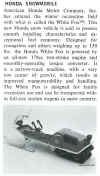

Hubert
Built north of Hillman by the Hubert brothers. The one
pictured is their second attempt of building an OSV / Icemobile. It
started out in the late 1950s as a snowmobile with an auger drive
out of Hay Bailer. From there using two drive wheels with
double roller chains in-concert with cleats. In the
early 1960s it was converted into an Ice-Mobile using a wheel/tire
with chains. It is powered by a Mercury Chainsaw engine most
likely from a Disston/Mercury Two-Person Chainsaw. The
skis are an early IFS Spring Assist type coupled to chainsaw bars.
It is in a private collection.
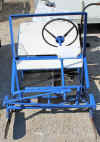


Humphrey
Alfred H. Humphrey of Kalamazoo invented a track
conversion platform to allow motorcycles for traveling on snow. He
filed for a
patent in 1966; awarded in 1968.

Ice Auger
Machines
When you talk about Michigan Snowmobile or OSV
Manufactures/Inventors history in general most people think nothing
new has happened in a long time. Well, that's not the case. Ice
Auger Machines is a great idea and project in work from an Upper
Peninsula native son. Their website has videos and Social Media
links at iceaugermachines

Lacasse
Joseph A. Lacasse's, of Lake Linden, Motor Sleigh basic drive train
is similar to the Rastello; however, unique because it took into
account the various snow depths over the drive surface--power to the
ground was the same even if the snow or ice terrain was uneven.
Patent awarded in 1922.

Lakeside Machine
Lee Imhoff of Lakeview, Michigan in the early 1960s wanted to
improve the inherit design flaws of snowmobiles, steering difficulty
and rapid equipment wear. Also, it made more sense to develop an
four-seasons vehicle capable of traversing various surfaces. His
three-wheel, high floatation tires, design coupled with quick change
of tires to skis and vice-versa was excellent. It is not known
exactly how many were made. If you can help with more
information please contact us.

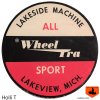
Latshaw
Latshow, a Paw Paw High School Instructor, made a motorcycle powered
sleigh using sharp pronged wheel to transmit power to propel it. He
was often seen in the winter of 1916 on Paw Paw streets.
Looking for more information, can you help?
Lawrence
Outboard motors are portable for use on different boats. Why can't
there be something like that to power sleds and toboggans Robert A.
(Bud) Lawrence of Brimley must of thought. He worked on his idea and
in 1947 applied for a
Patent that was granted in 1950 for his Lawrence Snow Tractor. I
have seen either Lawrence's tractor or something like it years ago
in the early 1970s with my father visiting an old Great Lakes
Sailing buddy. Maybe by raising awareness in this project someone
can find one or more information about it.
![]()
Lehtonen
Negaunee resident Frank Lehtonen's Automotive Sled was unique that
converting an automobile into a Motor Sleigh only required removing
the back tires and bolting on a track/runner assembly. His invention
is a early adaptation of the now famous Rubber Track Conversion
systems. The track(s) enclosed into a housing with runners minimized
skidding and drifting on throttle up. You could leave the front
wheels on or quickly switch out to skis. Frank's patent application
(US1104682)
was filed on Jan. 21, 1913 and approved on July 21, 1914.

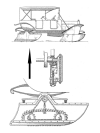
Limvna
In early 1928 an Ice Boat built by Ben Limvna of Mt. Clemens
demonstrated its capabilities on Lake St. Clair with Commander
Walter Brennan of nearby Selfridge field in attendance. Equipped
with a nine-cylinder engine, this OSV reached speeds just shy of 150
mph. Capable of carrying six persons stopping the streamlined craft
was via a cast-iron spiked scab brake.

Lorenzen
Like the Snow-Trac (below) the Lorenzen Ice and Snowsleds were hand
built by individuals using blue prints from the Lorenzen Propeller
Company Niles, Michigan. Unlike the Snow-Trac, where you had to hunt
down parts, you could buy almost everything you needed through
Lorenzen much like the Simko Power Sled. Starting out as a Propeller
company they learned during the Depression you had to diversifiy to
survive. They even sold Motor Scooters. Using a Harley Davidson 45
engine during testing the Lorenzen Penguin model hit 75 mph using
ice runners and 45 mph with snow skis. Not much is known
about Lorenzen after World War II, can you help provide more
information?


Maitland
Arvin Maitland of rural Osceola County was a true Renaissance Man.
A musician . A tool and die maker. A model railroad builder.
An USAF aircraft technician during the Korean War. A stone
mason. A college graduate. A sawyer. A mechanical genius. And
an inventor, so much so it's on his grave marker. His most
well known invention, world-wide, is the Slip-On Locknut. He
also invented the powered Dump-style hauler along with many other
things. While he didn't invent the snowmobile, he designed and
made what is believed the last antique styled rear-engine type
snowmobile in early 1971. It first had a four horsepower
Tecumseh, then he used a five horse Wisconsin. It had a top
speed of 30 mph. It was well known in the Rose Lake area often
seen pulling kids on a sleigh. Sadly, the snowmobile doesn't
exist anymore. Special thanks to Jay McNally for some background
information and use of his photo of Arvin and his sled.

Manta (Racing)
Bob Bracy while at Leisure Vehicles Inc (LVI) learned great
deal about snowmobile racing after the 1972 "bandit" (see Raider
Racing section below). The "bandit" was heavy was the biggest issue.
After Bob left LVI he formed A Robert Bracy Enterprise (ARBE)
products and made it a mission to create lightweight, quality,
products. ARBE end use snowmobile racers were the Single Track
and Twin Trac Mantas.
Single Track
With testing on and off the track in 1973/4 they created the 1975
Manta Single Track (MST) racer mainly to showcase many of their
products. Most notable: Lightweight Chassis, Transfer Master
Aluminum Slide Rail Assembly, Phase 1, 2, and 3 Cobra Ski
Assemblies, Titanium Track Cleats, Hot Tip Studs, Aluminum Fuel
Tanks just to name a few. Twenty-five MSTs were built and at this
time only three are known to exist. The MST came in at an unheard of
250 lbs net weight; offering either a 340cc or 440cc Sachs RX Free
Air engine.

Twin Trac
ARBE finished their Twin Trac Manta prototype racers is finished
just in time for the 1974 SnoPro race at nearby Imlay City.
The Twin Trac showed promise at Imlay City and then ran on the
Michigan International Snowmobile Association (MISA) to finish the
season. Michigan snowmobile racer Bud Bennett, who had contact
with Bob before, saw the Twin Trac and spoke with him on
improvements. In the end, Bob asked Bud to race for ARBE.
The 1975 race season issues (chain case related failures) were
identified and solved. The Manta was running Sachs Free Air Engines.
Mikuni carburetors and racing exhaust designed by Michigan Motion
Industries were installed. Things went OK, but OK wasn't good
enough for Bob and his team. Knowing that in 1976 they needed
to really step up their game and Liquid Cooled Engines were the
answer. The 1976 Manta Race Team was impressive, chassis
changes (such as Ram Air Ducting direct to the carburetors and the
Yamaha 440 Liquid Cooled engine were game changers. Of note,
during the Karwartha Cup and Weedsport races the Mantas finished top
three in many heats with a few wins. After the season ended, ARBE
concentrated on a 1977 consumer Manta snowmobile (See Manta Trail
below).
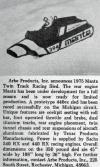
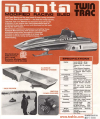
Manta (Trail)
After success with the Manta Twin Trac racer ARBE planned to release
a consumer Manta for 1977, it would take five years for it to become
reality. Robert Bracy's dream of a cockpit style, rear engine,
twin track snowmobile for consumers returned with the 1982 Manta
Mark I. Very few were built, by order, powered by a 437cc LC CDI
Kohler with two Mikuni 32mm carbs. A dead give-a-way it's a Mark I
is the Twin Lights mounted on top of the roll bar. In 1983,
the Trail Manta was offered with two engine choices built in Romeo,
Michigan.. A 440cc oil-injection or 500cc, both liquid cooled.
Standard features: Rear 6.5-inch travel suspension; Front IFS with
5.5" travel and anti-sway bar to limit side roll; full upper body
removal in less than a minute with separate engine cover made
servicing and maintenance access easy; seat belt system;
modified butterfly steering wheel with rack and pinion; foot
throttle and brake pedals; side fill fuel tank; tuned dual exhaust;
heated cockpit that help keep the wind and cold out. During
the 1985 Snow-Goer Shoot Out in Cable Wisconsin the Trail Manta
finished 2nd on timed Lemans style course a split second out of
first. The Trail Manta would only be in production a few short
years. Mr. Bracy would have to wait over a decade to release
his next Twin Track, the Trail Roamer, he never gave up.
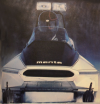

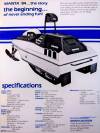
Marr
Marr Power Driven Sled was designed by Walter D. Marr of Flint. This
OSV (Snow-Plane) vehicle was unique because of hydraulic
lifting/lowering of wheels. Not much else is known except for the
approved
patent in 1943. Of note, the patent shows a sleigh (figure 1) in
use with retractable wheels. One would think of Mr.
Marr's talents (he got from his famous father Walter L. Marr of the
Marr Autocar and later Buick) as a engineer were probably directed
towards the war (WWII) effort.

Massey-Ferguson
Many know that Massey-Ferguson (MF) snowmobiles were made in
Des Moines, Iowa and then by Scorpion (re-branded) in Minnesota.
But, most don't know that MF had some big Michigan connections. MF
sleds starting in 1969 had everything going for it, rugged well
build, a great dealer network via MF farm equipment dealerships,
their own clothing line, and a marketing campaign 2nd only to
ski-doo. Farmers bought a big percentage of them; however, MF sled
sales were soft to the general population. MF's design team was in
Detroit and was determined to re-invent its self for the 1973
models. Design team led by Thomas Denny and Jack Rose the new 1973
models MF touted as "... the most improved sled on the trail." And
they were right, sales jumped 60 percent. The 1974 MF was basic 1974
re-brand facing other manufactures that focused on the newest
biggest market -- the muscle inspired race sleds. Sales tanked and
MF contracted out to Scorpion to start building re-branded Scorpions
from 1975 to 1977. Also, MF sold re-branded Charlotte based GAP
Sno-Cruisers as there own. They were one of the few that actually
had GAP Sno-Cruisers in their dealership brochures.


Montgomery Wards Mini 99
Made by Yard-Man in Jackson, the Mini 99 is a Sno Cub with a
Montgomery Wards scheme.
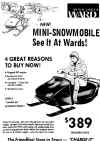

Moffitt
Floyd A Moffitt in 1906 bought a farm west of Gaylord and found
the winters in the heart of the southern peninsula snow belt not
only brutal, but hard to get around. After a few years Floyd and his
brother, Ross, started working on a better way for winter travel.
Both were well versed not only with brains, but with Floyd being a
farmer and Ross an expert in home and commercial construction
(decades later Ross would be Secretary for the Lansing Building
Trades Council) it's no surprise their Automobile-Sleigh Runner
brought OSVs out of the dark ages with one of the first modern
snowmobile tracks and slide suspensions in the mid-1910s (Patent
Application).
Of note, Floyd's farm was only about 10 miles away from Ray
Muscott (see below) lived. I've got to believe it's very
plausible Floyd and Ross'; Ray's paths crossed back in the early
1910s. Also, talk about Six Degrees of Separation, the Coal Fired
Steam Locomotive with tracks and skis to haul lumber out of the
Deward Lumber Tract was 10 miles from all three! Floyd passed
away in 1948 and his grave is a short distance near my parent's
graves, when in the area I sometimes stop by and give thanks.



Muscott
It is often disputed who made the first non-human powered
snowmobile, earliest reports of one was in the Northern Lower
Peninsula of Michigan near the turn of the last century. It was a,
Coal Fired, Steam Locomotive fitted with tracks and skis to haul
lumber in the Deward Lumber Tract.
Ray Muscott who lived near Waters at the time was granted one of the first joint snowmobile patents: In Canada (CA165326A, 1915) and in the USA (1188981, 1916). Was Muscott inspired by the locomotive, did he even know about it, located less than seven miles southwest of Waters? We will never know. We do know later models of the Muscott's "Motor Sleigh" was used to modify vehicles like the Ford Model T and others to transport supplies, people, and their belongings cross-country during winter. Of note, in the late 1910s and early 1920s three Motor Sleighs were used to transport Mail in Isabella County.
Muscott didn't stop with his first invention, he improved it so
much in a very short time he applied for another patent (Thread Belt
Attachment for Trucks) on September 25, 1918 and on November 15,
1921 it was approved, 1397139. Many snowmobile historians feel
Muscott, his family, friends, and workers have never got their
credit due that has lead to so much utility and pleasure. His grave
is a short distance from where I live. As with Floyd A Moffitt, when
I pass by I often visit to give thanks on behalf of Snowmobilers
everywhere. CDN (1915):
Claim |
Dissertation |
Drawings USA (1916):
Patent | 1921 Patent

Mystery Sled
Michigan Antique Mystery Snowmobile. Can you help ID or know
anything about this sled? Parked next to a Dwyer for comparison at
the Rogers City 2019 Event. Was obtained decades ago from Trout Lake
(UP) area about 12 miles north of Brevort in Chippewa County. Was
Coverland Electric utility services snowmobile. A Snowmobile
Registration ID shows make Arctic Cat (but it is not an Arctic Cat).
Front and back photos for comparison. Also, look on both sleds:
Where the steering spindles go through the front to the skis; the
steering boxes; speed control boxes; Front suspension frame
mountings; and rear axle sprockets. Yes, back in the day many items
built for "the farm" were common across platforms. But, this seems
like a lot. Any help on further information would be greatly
appreciated. Please contact us or the folks at the Snowmobile Museum
in Naubinway if you can help. Thank you.



Nilson
Karl Nilson, a Swedish immigrant that settled in Detroit, was very
mechanically minded and fascinated with motor vehicles. With most
motor sleighs of the time he though they were very heavy and
sometimes rode like a brick that would give a good shake the
occupants and cargo. His scaled down version of a motor sleigh used
a motorcycle engine, the traction wheels in front of the drive
shaft, and shock absorbing means that enable the machine to carry
loads of varying weights with the minimum amount of vibration. Also,
when finished with his first prototype it was one of the most
futuristic motor sleighs of the time. He filed for a patent (US1574924)
in 1923 and was approved on March 2, 1926.
![]()
Pasko
The Pasko Motor Sleigh was designed by John Pasko of Flint in the
late 1910s and
patent awarded in 1920. To boil it down it's half Sleigh and
half (before) Sno-Motors with one
screw drive in the rear. Sort of like a Marine Arneson Surface Drive
only decades earlier for ice/snow travel.

Premier
RPC
Premier Recreational Products Corporation of Holly, Michigan was
started in the late 2000's out of frustration as the four remaining
snowmobile companies had moved away from the family segment and were
no longer building a mid-size snowmobile. Seeing the need for a
modern mid-size snowmobile for families to ride together out on the
trail, the Enforcer 300cc (and later the Enforcer 350cc) 4-stroke
EFI models were developed to fill that market void with designs
geared towards junior riders and smaller adults in an effort to
offer a true trail-worthy, mid-size entry level snowmobile. Unable
to acquire the financial backing needed to push the Enforcer into
production, the project was abandoned in 2014.


Prior
The Prior Motor Sleigh in a nutshell was to adapt the engine to
accept a propeller assembly; hand linkage to a governor that
controlled propeller speed. Porter Prior of Ypsilanti applied for a
patent in late 1925 (US1697693)
that was eventually awarded in early 1929.

Raider | Roamer
Perhaps the most famous Michigan Made consumer
snowmobiles. Robert Bracy and Engineer John Drawe formed Techtron
then Leisure Vehicles Incorporated (LVI) after Mr. Bracy completed
the Ford GT40 MKII and MKIV racing projects. The Ford GTs were
rear engine and had excellent handling compared to front engine
autos so he thought Snowmobilers could benefit from an "updated"
rear engine design. In early 1968 LVI started design work; in
July 1968 the first prototype (see photo) was built and testing
started. After testing Mr. Drawe designed a snowmobile with the
driver seated in a cockpit style layout. It also had double tracks,
enclosed body, and rear-engine placement. LVI starting out in
Romulus. The initial year in 1971 two models were offered, the
Roamer (8hp, Four-Stroke, Briggs and Stratton); Raider (340cc,
Two-Stroke, JLO). About 100 Raiders and 50 Roamers were built.
After the first year the Roamer name was dropped. In 1972, the
Roamer name was dropped and the Raiders were larger with an updated
body. The 1972 Raider offered four different models (with CCWs 290,
340, 400, and 440cc engines) desinated by one, two, three or four
hash marks on the rear of the body. Mr. Bracy reported things were
going well and 2000 units were built. The biggest challenge was to
convince conventional Snowmobilers of the Twin-Track advantage.
What helped is he also offered a Wheel Conversion Kit for warm
weather riding. Also, LVI
built the Bandit Racer (Raider Racing below). The third year (1973
model) the Raider got a complete redesign because of the
joint-effort with Honda (see Honda Raider), it was a great year for
the Raider with 8000 units made. After the 1973 model year LVI's new
models, the 1974 Eagle and Double Eagles were offered. Sadly, Mr.
Bracy left the company in 1973 (to form Manta) and two years LVI was
just one of over 100 snowmobile companies to go out of the
snowmobile business. Of note, a company in New York saw big
poetintal for the Raider as a four-season ORV. They also built
a wheel kit for it (see sales flyer below).


Raider (Racing)
In 1972, Leisure Vehicles Inc (LVI) tried their hand at racing with
the limited build "bandit." About 50 "bandits" were made with mostly
Hirth 440 engines, however; a few had 340s and a couple had the 650.
At the end of the production a few came with Raider consumer CCWs.
The "bandit" offered many safety features (enclosed cockpit;
distance between engine and fuel tank were the biggest) over
conventional race sleds. In the end the "bandit" was just too heavy
to compete. LVI turned their focus on building a lighter race
sled (see Manta Racing)). The only known pictures of the
"bandit" racing are shown below at the Detroit Snowmobile Races and
another location (can you help ID).

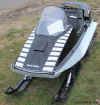

Rastello
Charles Rastello of Hancock Self Propelled Sled is one of
the most radical OSV designs to come out of Michigan. It might take
you a few times to look at the
patent (1913) drawings and read the description before you
understand it. Just think of a screw drive garage door opener moving
legs backwards, lifting them, moving forward, and lowering them to
cycle again..


Rintala
Made in the Houghton area in 1966. The Rintala is a one off
snowmobile with a 1958 Briggs & Stratton coupled to a Salsbury drive
system. The track is an old conveyer belt with metal cleats; 1950s
Plymouth Belvedere steering wheel. The Rintala is on loan to the
Snowmobile Museum in Naubinway.

Scatmobile
Was a true ATV made by the New Frontier Corporation in Grand Rapids
from 1964 until 1978. Most of the production models were made
between 1967 to 1971. Was marketed as a Land Mobile. Skis added in
the winter. In hard packed snow there was no reason to add the
optional cleated track. Owners report the machine is way more nimble
than it looks.




Scorpion
Not the Scorpion from Minnesota. The new Scorpion started out
in Janesville, Wisconsin in the late 1990s where 22 prototypes were
built. SRP Inc moved to Michigan (much better for corporate
taxes) and 75 sleds were produced and sold in the Mid-West Snow Belt
states of Michigan, Minnesota, and Wisconsion. With five
models in the works (500cc Sting, 600cc Whip, 700cc TKX, and the
800cc Sidewinder SS) TKX 890 was their flagship with a PSI/Scorpion
Millennium 890cc L/C Twin engine with 160hp coupled to a P85 clutch
to a Direct Drive system driving the axle from the secondary clutch.
Bottom Line: No jackshaft and chain case. Here are a couple
videos Video 1 |
Video 2 of the TKX in
action. The two-page overview brochure is below, thank you Greg S
for sending it in.

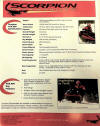
Simko
Power Sled
You could either buy an entire Simko Power Sled or order
a kit. There were made in Allen Park and Ecorse by a company started
by Jim Simko. They were a big hit on Lake St. Clair and the
Saginaw Bay in the late 1950s to late 1960s. They came in many
different models (lengths, number of passengers, and engine size).
Also, very popular on the many frozen waterways in Northeastern
Michigan. If you look hard enough you can still find them in Yard
Sales or a couple times a year on Craigslist. A racing Simko
with a 10hp Briggs and Stratton and a Tillotson Carb with a metal
ram tube hit 60 mph in 1965 during the Detroit Power Ice Boat
races. Most Simkos were powered by a West Bend Power Bee Go-Kart
engine. The Simko was in the January 1966 issue of Popular
Mechanics on
pages 130 and 131. Here is a 1962 Simko
video.
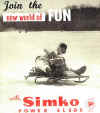

Ski-Kat
One of the most loved and highly sought after Michigan made
snowmobiles. Based out of Metro Detroit by Sport King in the
late 1960s. Also, an optional wheel kit was available. They were
manufactured in Rogers City.



skiroule
Almost all skiroules were made in Quebec up to 1977.
By ways of business dealings and buy outs the last skiroules were
made in Crystal, Michigan. In 1978, Crystal's Jasar Inc (aka
JLC)
decided to build new skiroules. In late
October 1978 a letter went out to dealers explaining they were behind, but
pressing forward. In 1979, the skiroule
Sprint srx-440 was introduced. About 15 were produced and if
you are lucky while attending a Vintage Snowmobile Show nowdays you might
see one. Most Michigan skiroules were 1979 models. In 1981, another Sprint, this time a prototype was made. This
sled in now in Canada. During the Crystal (Michigan) years some
of the Michigan skiroules were a mix of a lot of different year
parts and pieces, all NOS. The last skiroule was made around 1990,
the RTX 447. Of note, Crystal Marine and Nelson's in
Greenville were selling JLC skiroule parts in late 1978. Special thanks goes to Doug M and Les H for
pictures and info on the Michigan skiroules. Also, if you are on Facebook, this
page has a great deal of information and pictures on the
Michigan skiroules.
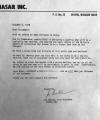


Sno Cub
Made by Yard-Man in Jackson, the Sno Cub is a few of the true
mini-sleds. Made for a few years starting in 1971 they came
with the bullet-proof one cylinder JLO 99cc engine.
Accessories, sold separate, Kick Stand, Light Kit (Head/Tail),
Saddle Bag, and a "Sno-cover". Of note, many times the dealer
would just install the kick stand out of the crate-- made it easier
to move around.

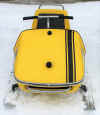
![]()
Snow Jeep
George W. Bettes was a true visionary in the sense of improving
things; however, instead of just thinking about it he did it. Born
in 1887 he grew up on a farm outside of Sparta. There he learned and
honed his mechanical skills. Before he graduated High School he
built a steam powered race car. After school owned and worked at
auto dealerships. He saw the need for road safety; built and
patented the Road (Center and Shoulder) Marking Machine. George also
invented the Underwater Diving Suit/Helmet with two way
communications. He also was extensively involved in Aviation and
Filming. As far as snow travel, he saw the need for a lightweight
(at the time) snowmobile to haul equipment to the North to the South
Poles and everywhere in between. Over 10 years he designed and build
several highly sucessful over the snow vehicles before his crowning achievement--the Snow Jeep.
It easily was the best snow machine over many undergoing testing at
Fort Brady in the 1940s. It weighed only 850 pounds and could
pull over 1,000 pounds of equipment and fuel, it's range was 500
miles! The Snow Jeep was also tested in northern Canada on James
Bay. So impressive was his machine he became a member of The
Polar Exploration Society. For more on Mr. Bettes please visit
the Sparta Township Historical Commission page on him at
spartahistory.org


Snow-Motors Inc
Perhaps the most unique Michigan Made OSV came into being in the
1920s when a few Motor City automakers joined forces and started
Snow-Motors Inc. The twin screw-drive system they applied to the
Fordson tractor (sometimes called the Fordson Snow Devil); Chevrolet
and Hupmobile autos. The concept was patented in 1923. Orders
were taken from Canada, Norway, Sweden, and of course the USA. The
photo of the enclosed cab model is the only known picture in
existence. If you click on the
video picture
it will take you to a great 10 minute video. Here's another
video of a restored Snow-Motor. There was a need for such a
vehicle in the snow belts and lake effect regions of the world;
however, timing might of been an issue. A short time later in 1927
the Stock Market crash spelled the end to many early snow vehicle
inventions and creations.?


Snow-Trac
The homebuilt Snow-Trac was featured in the November 1963 issue of
Popular Science (PS) magazine starting on page 122. E.F.
Lindsey, who wrote many articles for PS and others did a great job
as usual covering the Snow-Trac. There are at least four Snow-Tracs
in Michigan. All with a little different twist as the builders put
their touchs and modifications on their own. Examples: Some had a
hand drive engagement and some used a Salsbury 500 drive system; all
had fuel tanks in different locations. Plans and PS article as
follows:
Page 1 and 2 |
Page 3 and 4 |
Page 5 and 6 |
Page 7 Also, here is a great
video of a Snow-Trac in
action thanks to Cliff S. Also, special mention to Steve L of
The Winning Edge Magazine for the color photos. We are working
on who and where the Snow-Trac designer is. Good chance with
as many in Michigan it is here; if you know more please let us know.


Stanaback
Two Stanaback snowmobiles were made in 1967, in Grand Rapids.
The first one used a Villiers engine made in England that had a kick
start (Villiers engines were also used in early Sno Bug snowmobiles
made in Sudbury, ON). The second had a Lloyd Engine bought via
Trail-King International in Portland, Michigan. For more
information and to see the surviving sled on
display please visit the Top of the Lake Snowmobile Museum in
Naubinway.


Stanaback TAV
Besides the Stanaback snowmobile, Ken P Stanaback designed the
Stanaback Trans Axle Vehicle (TAV) platform to use in-concert with a
motorcycle. He applied for a
patent in 1965; awarded in 1968. Ken was a talented
person, he designed and built a quarter-scale train with a Subaru
engine to power the locomotive and six seat passenger car. His track
was about 4,000 feet long and had a trestle over a half acre pond.

Surrell
It started as a 1923 Chevrolet Touring Car from Surrell Chevrolet in
Newberry. In late 1926, Charles Surrell and friends constructed
transformed it by making wooden skis for the front and two sets of
Chevrolet wheels with tractor belts with hand-made lugs for the
rear. The Surrell ski might be the first known use of hand grips at
the front of a snowmobile ski. It was made at the Service Station in
town, also owned by Surrell family. Surrell's mechanics made many
OSVs in the 1920s and 1930s. On February 4, 1939 they even
marketed their OSVs in the Newberry Winter Carnival parade.

Swanson
Barney Swanson, owner of Swanson's Garage and Towing in Beulah, seen
many people not used to the NW Lower Peninsula Lake Effect Snow Belt
get stranded while coming north during the winter. In 1924, he
modified an old Ford Chassis moving the front wheels to just before
the rear wheels; made an chain-type caterpillar drive and a set of
sleigh type skis. It worked great and gathered much interest in the
Crystal Lake area. Swanson made at least three more for use by a
Doctor and two wealthy families before moving on to other ventures.
![]()
Thomas-Tyler
Like Penny-farthing? What! AKA High wheel or High Wheeler
bicycle. They were popular in the 1870s/80s. You know somebody from
Michigan seen one of those and thought I'm going to make a
snowmobile out of this beast! Well, John D. Thomas and Amos H.
Tyler from Petoskey did and received
patent for it in 1889 for their Sled-Propeller. With outriggers
for stability their Thomas-Tyler OSV must of flew on ice and hard
packed snow! Of note, this is the earliest we can find anything
related to a snowmobile this far back in Michigan. 1889 is a long
time ago!

Timberwolf
Made for five years in Sault Ste. Marie, MI by Northsport Industries
(NI) starting in 1969. One is on display at the Top of the
Lake Snowmobile Museum in Naubinway. In 1971 NI offered three
different models: 395 (JLO single), 400 (JLO Twin), and the 800 (JLO
744 Twin). An unique safety feature of the Timberwolf, it
floated on water. NI even built a Racing Timberwolf for
the I-500. A total of eight Timberwolfs were made, four are
accounted including the racer. Here's a rare
video (starts at
00:14) showing the
Timberwolf before the start of the 1971 Soo I-500 race.
For more info and a picture
click here
to view the Timberwolf at the Top of the Lake Snowmobile Museum.
Special thanks to John McGurk for his knowledge and access to his
Timberwolf memorbila.
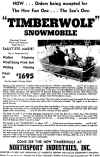


Trail Roamer
Made around the turn of the last century, Bob Bracy's passion for a
Cockpit style twin-track consumer snowmobile continued. In
2001, under Three-R Industries (TRI) his Trail Roamer first (and
only year) hit the market. Sadly due to health reasons Bob passed
away a short time later. TRI also made Trail Patrol (TP)
offered by Grooters Specialty Products. Of note, the TP had Police
Lighting, Communication Equipment, Heating System, and GPS
Navigation. Bob also offered the Gold Eagle Trail Roamer, a
30th Anniversary Tribute to the original 1971 Roamer. This limited
build was loaded and with a $25,000 price tag included an owner
plaque, one ounce Gold Eagle coin, and certificate with option to
buy 2,000 shares of TRI stock. It would be really cool to see
current pictures of any these. Can you help?
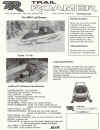
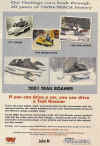
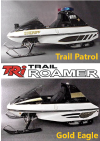
Vipond
Kalkaska resident Edward Vipond's Motor Sleigh invention was to
propel the vehicle by alternating rear runners (two on each side).
In forward motion each runner would: move backward while contacting
the surface, lift up, move forward while up, and down to start the
process over. Vipond patent application (US1202538)
was filed on March 14, 1916 and awarded on Oct. 24, 1916.

Vroman
Two Vroman snowmobiles were made in Wolverine in the very early
1960s by two talented brothers who were Tool and Die makers. Their
first machine was powered by a 7hp McCulloch Chain Saw Engine. They
learned a great deal with this first sled; a major issue was
inadequate power. The second Vroman (in a private collection) had
many refinements over the first; the Briggs and Stratton Model
23(hp) was a huge improvement. I learned a great deal about the
Vroman from Roger J and John M at the 2019 Rogers City Event. The
first picture is from the Roger and Karen J's Dwyer display often
seen at the shows. The rest from John M.


Waywego
Ralph Webber of Trenary made the Waywego in the mid-1960s. There are
five left known to exist. The Snowmobile Museum in Naubinway has a
beautiful restored Waywego on display; the others are in private
collections.



Wentworth
Bob Wentworth from Metro Detroit, had a rare skill of being an
expert in electrical, fabrication, and mechanical disciplines.
There are and continue to be many well known Michigan snowmobile
racing builders who modify, sometimes heavily, sleds to improve them
for a specific race or circuit. But, Mr. Wentworth deserves
special mention and identified as an inventor, because like Burt
Monroe with his motorcycle, over decades he was always trying to
find ways to improve his creation--well into the mid-2010s.
The end result of a Kawasaki Triple 750 motorcycle engine coupled
with his electrical spark timing system along with just about
everything else he hand made resulted in one of the quickest
snowmobiles ever made under 800cc, if not ever.

![]()
![]()
Westendorf
The only Westendorf was built in 1936 in Bay City by Fred
Westendorf.
More of a power sled than a snowmobile it was used on ice (fishing)
and hard-packed snow. Power to the ground was via a small tire with
many chains (see picture below) from a Briggs & Stratton 1.5hp that
Fred bored out for more power. You can see another picture
here and in person at the Top of the Lake Snowmobile Museum in
Naubinway.


Wing
CB Wing from St. Ignace built his first Aero Sleigh (AKA Snow Plane)
in the mid-1910s what would be the first of many. The Wing Aero
Sleighs were an excellent form of transportation for a variety of
purposes. Production stopped in 1957. The second picture is the same
Snow Plane as picture four taken decades later when used for
transporting people and goods to/from Mackinaw Island.
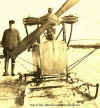

Michigan Branded
Snowmobiles often thought built in Michigan, but were not.
Chrysler
The Sno-Runner was made by Chrysler Outboard Corp. in Hartford,
Wisconsin.
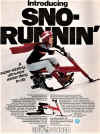
Lansing
The Lansing Snowmobile was in reality a Hydrocraft made by the The
Lansing Hydrocraft Company in Toronto, Ontario.
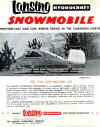
Ski-King
Was made by Lionel Industries in Quebec for Outer Sports Inc. in
Lansing.

Sno-King
Made in Quebec by Lionel Industries for R & S Enterprises in
Lansing.
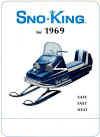
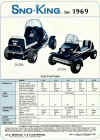
Trail King
Trail King was made by Lionel (Sno Prince) in Canada for Trail
King International in Portland, Michigan. Trail King offered
snowmobiles for only a couple years (1970 and 1971). They were more
known for their high quality snowmobile wheel kits,
ATVs,
Mini- and Trail-Bikes, and
Sleighs.

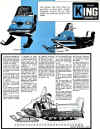

Tour-A-Sport
Tour-A-Sport was a joint effort by Eagle Tie Machine Company (ETMC)
(Sno-Hawk) in London, Ontario and Tour-A-Home of Michigan. Right
after talks between the two started ETMC sold out to Homes-Blunt Ltd
in Sarnia. Tour-A-Sled was a Sno-Hawk painted white white
Tour-A-Sled branding offered in Port Huron. The Tour-A-Sled sleigh
was a Bluebill with, of course, Tour-A-Sled branding. Not much more
is known other than it was a short venture ('68-'69).

Dedication and Thank
You
Dedicated to those who invented; designed; made; sold; serviced; and
owned Snowmobiles, Over Snow Vehicles (OSV), and End Item related
OSV products made in Michigan. Thanks to those who helped contribute
with special mention US Patent Office, Google Patents, Google Books,
Popular Science magazine, The Winning Edge Magazine, Lisa from the
Lakeview Area Museum, Oakland County Historical Resources, Top of
the Lake Snowmobile Museum, Richard L (Editor and Publisher of the
Presque Isle County Advance), the late Bud Knapp for inspiration,
Chris B of Premier RPC, Aumann Auctions, Bill S, Bob H, Bob L and Norma in Special
Collections at the Alpena County Library, Bob W, Brent C, Charlie
and Marilyn V, Cliff S (Mini-Bike OSV Section and Snow-Trac), Tom
and Linda D, Doug
L, Doug M, E.F. Lindsey, Edward J, Holli T, Jeff H, John Gendregske,
Kevin M, Larry K, Les H, Matt B, Richard H, Roger and Karen J, Shane
S, Steve B, Steve H, Steve and Sherry L, Todd H, Todd K, and John M
for access to his extensive research and photos.













